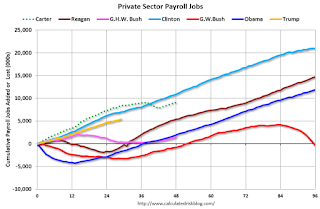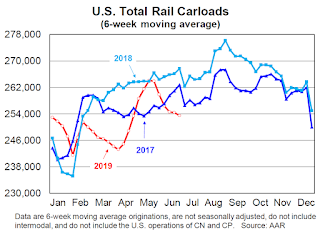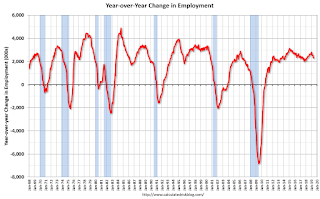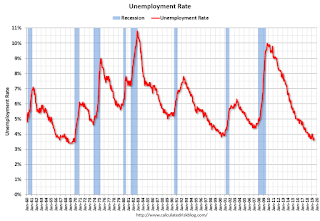by Calculated Risk on 7/07/2019 11:18:00 AM
Sunday, July 07, 2019
Public and Private Sector Payroll Jobs During Presidential Terms
By request, here is another update of tracking employment during Presidential terms. We frequently use Presidential terms as time markers - we could use Speaker of the House, Fed Chair, or any other marker.
NOTE: Several readers have asked if I could add a lag to these graphs (obviously a new President has zero impact on employment for the month they are elected). But that would open a debate on the proper length of the lag, so I'll just stick to the beginning of each term.
Important: There are many differences between these periods. Overall employment was smaller in the '80s, however the participation rate was increasing in the '80s (younger population and women joining the labor force), and the participation rate is generally declining now. But these graphs give an overview of employment changes.
The first graph shows the change in private sector payroll jobs from when each president took office until the end of their term(s). Presidents Carter and George H.W. Bush only served one term.
Mr. G.W. Bush (red) took office following the bursting of the stock market bubble, and left during the bursting of the housing bubble. Mr. Obama (dark blue) took office during the financial crisis and great recession. There was also a significant recession in the early '80s right after Mr. Reagan (dark red) took office.
There was a recession towards the end of President G.H.W. Bush (light purple) term, and Mr Clinton (light blue) served for eight years without a recession.

The first graph is for private employment only.
Mr. Trump is in Orange (29 months).
The employment recovery during Mr. G.W. Bush's (red) first term was sluggish, and private employment was down 821,000 jobs at the end of his first term. At the end of Mr. Bush's second term, private employment was collapsing, and there were net 382,000 private sector jobs lost during Mr. Bush's two terms.
Private sector employment increased by 20,979,000 under President Clinton (light blue), by 14,714,000 under President Reagan (dark red), 9,039,000 under President Carter (dashed green), 1,511,000 under President G.H.W. Bush (light purple), and 11,890,000 under President Obama (dark blue).
During the first 29 months of Mr. Trump's term, the economy has added 5,370,000 private sector jobs.

The public sector grew during Mr. Carter's term (up 1,304,000), during Mr. Reagan's terms (up 1,414,000), during Mr. G.H.W. Bush's term (up 1,127,000), during Mr. Clinton's terms (up 1,934,000), and during Mr. G.W. Bush's terms (up 1,744,000 jobs). However the public sector declined significantly while Mr. Obama was in office (down 269,000 jobs).
During the first 29 months of Mr. Trump's term, the economy has added 243,000 public sector jobs.

After 29 months of Mr. Trump's presidency, the economy has added 5,613,000 jobs, about 429,000 behind the projection.
Saturday, July 06, 2019
Schedule for Week of July 7, 2019
by Calculated Risk on 7/06/2019 08:11:00 AM
The key report this week is June CPI.
Fed Chair Jerome Powell will testify on the Semiannual Monetary Policy Report to the Congress on Wednesday and Thursday.
3:00 PM: Consumer Credit from the Federal Reserve.
6:00 AM ET: NFIB Small Business Optimism Index for June.
 10:00 AM ET: Job Openings and Labor Turnover Survey for May from the BLS.
10:00 AM ET: Job Openings and Labor Turnover Survey for May from the BLS. This graph shows job openings (yellow line), hires (purple), Layoff, Discharges and other (red column), and Quits (light blue column) from the JOLTS.
Jobs openings decreased in April to 7.449 million from 7.474 million in March.
The number of job openings (yellow) were up 5% year-over-year, and Quits were up 4% year-over-year.
7:00 AM ET: The Mortgage Bankers Association (MBA) will release the results for the mortgage purchase applications index.
10:00 AM: Testimony, Fed Chair Jerome Powell, Semiannual Monetary Policy Report to the Congress, Before the House Financial Services Committee, Washington, D.C
2:00 PM: FOMC Minutes, Meeting of June 18-19, 2019
8:30 AM: The initial weekly unemployment claims report will be released. The consensus is for 216 thousand initial claims, down from 221 thousand last week.
8:30 AM: The Consumer Price Index for June from the BLS. The consensus is for no change in CPI, and a 0.2% increase in core CPI.
10:00 AM: Testimony, Fed Chair Jerome Powell, Semiannual Monetary Policy Report to the Congress, Before the Senate Banking Committee, Washington, D.C
8:30 AM: The Producer Price Index for May from the BLS. The consensus is for a 0.1% increase in PPI, and a 0.2% increase in core PPI.
Friday, July 05, 2019
AAR: June Rail Carloads down 5.3% YoY, Intermodal Down 7.2% YoY
by Calculated Risk on 7/05/2019 04:52:00 PM
From the Association of American Railroads (AAR) Rail Time Indicators. Graphs and excerpts reprinted with permission.
Total U.S. rail carloads in June 2019 were down 5.3% (57,173 carloads) from June 2018, as just 4 of the 20 carload commodities the AAR tracks had carload gains. ... Last year was the best year ever for intermodal, but this year isn’t keeping up. In June 2019, U.S. intermodal originations were down 7.2% from June 2018, their fifth straight decline and the biggest percentage decline since April 2016.
emphasis added
 Click on graph for larger image.
Click on graph for larger image.This graph from the Rail Time Indicators report shows U.S. average weekly rail carloads (NSA). Red is 2019.
Rail carloads have been weak over the last decade due to the decline in coal shipments.
Total U.S. rail carloads were 1.02 million in June 2019, down 5.3%, or 57,173 carloads, from June 2018. It was the fifth straight monthly decline.
...
In 2019 through June, total U.S. carloads were 6.55 million, down 2.9%, or 195,168 carloads, from the first six months of 2018. Since 1988, when our data begin, only 2016 had fewer total carloads in the first half of the year.
 The second graph is for intermodal traffic (using intermodal or shipping containers):
The second graph is for intermodal traffic (using intermodal or shipping containers):U.S. intermodal originations totaled 1.08 million containers and trailers in June 2019, down 7.2%, or 84,002 units, from June 2018. The 7.2% decline was the fifth straight monthly decline and the biggest percentage decline since April 2016. … U.S. intermodal volume in the first half of 2019 was higher than every other year other than 2018 (see the middle right chart below), so it’s not like this year is a catastrophe.
Q2 GDP Forecasts: Around 1.5%
by Calculated Risk on 7/05/2019 11:34:00 AM
From Merrill Lynch:
A widening in the trade deficit and slower than expected inventory build in May were mostly offset by strong vehicle sales in June. On net, the data cut 0.1pp from 2Q GDP tracking, leaving us at 1.7% qoq saar. [July 5 estimate]From the NY Fed Nowcasting Report
emphasis added
The New York Fed Staff Nowcast stands at 1.5% for 2019:Q2 and 1.7% for 2019:Q3. [July 5 estimate].And from the Altanta Fed: GDPNow
The GDPNow model estimate for real GDP growth (seasonally adjusted annual rate) in the second quarter of 2019 is 1.3 percent on July 3, down from 1.5 percent on July 1. [July 3 estimate]CR Note: These estimates suggest real GDP growth will be around 1.5% annualized in Q2.
Comments on June Employment Report
by Calculated Risk on 7/05/2019 09:41:00 AM
The headline jobs number at 224 thousand for June was above consensus expectations of 165 thousand, however the previous two months were revised down 11 thousand, combined. The unemployment rate increased to 3.7%. Overall this was a decent report. Note: Temporary Decennial Census hiring for June is not available yet (something to watch).
Earlier: June Employment Report: 224,000 Jobs Added, 3.7% Unemployment Rate
In June, the year-over-year employment change was 2.301 million jobs. That is decent year-over-year growth.
Average Hourly Earnings
Wage growth was below expectations. From the BLS:
"In June, average hourly earnings for all employees on private nonfarm payrolls rose by 6 cents to $27.90, following a 9-cent gain in May. Over the past 12 months, average hourly earnings have increased by 3.1 percent."
 This graph is based on “Average Hourly Earnings” from the Current Employment Statistics (CES) (aka "Establishment") monthly employment report. Note: There are also two quarterly sources for earnings data: 1) “Hourly Compensation,” from the BLS’s Productivity and Costs; and 2) the Employment Cost Index which includes wage/salary and benefit compensation.
This graph is based on “Average Hourly Earnings” from the Current Employment Statistics (CES) (aka "Establishment") monthly employment report. Note: There are also two quarterly sources for earnings data: 1) “Hourly Compensation,” from the BLS’s Productivity and Costs; and 2) the Employment Cost Index which includes wage/salary and benefit compensation.The graph shows the nominal year-over-year change in "Average Hourly Earnings" for all private employees. Nominal wage growth was at 3.1% YoY in June.
Wage growth has generally been trending up, but has weakened recently.
Prime (25 to 54 Years Old) Participation
 Since the overall participation rate has declined due to cyclical (recession) and demographic (aging population, younger people staying in school) reasons, here is the employment-population ratio for the key working age group: 25 to 54 years old.
Since the overall participation rate has declined due to cyclical (recession) and demographic (aging population, younger people staying in school) reasons, here is the employment-population ratio for the key working age group: 25 to 54 years old.In the earlier period the participation rate for this group was trending up as women joined the labor force. Since the early '90s, the participation rate moved more sideways, with a downward drift starting around '00 - and with ups and downs related to the business cycle.
The 25 to 54 participation rate increased in June to 82.2% from 82.1% in May, and the 25 to 54 employment population ratio was unchanged at 79.7%.
Part Time for Economic Reasons
 From the BLS report:
From the BLS report:"The number of persons employed part time for economic reasons (sometimes referred to as involuntary part-time workers) was essentially unchanged at 4.3 million in June. These individuals, who would have preferred full-time employment, were working part time because their hours had been reduced or they were unable to find full-time jobs. "The number of persons working part time for economic reasons decreased in June to 4.347 million from 4.355 million in May. The number of persons working part time for economic reason has been generally trending down.
These workers are included in the alternate measure of labor underutilization (U-6) that increased to 7.2% in June.
Unemployed over 26 Weeks
 This graph shows the number of workers unemployed for 27 weeks or more.
This graph shows the number of workers unemployed for 27 weeks or more. According to the BLS, there are 1.414 million workers who have been unemployed for more than 26 weeks and still want a job. This was up from 1.298 million in May.
Summary:
The headline jobs number was above expectations, however the previous two months were revised down slightly. The headline unemployment rate increase to 3.7%.
Wage growth was a little disappointing.
Overall this was a decent jobs report. The economy added 1,033 thousand jobs through June 2019, down from 1,411 thousand jobs during the first half of 2018. So job growth has slowed.
June Employment Report: 224,000 Jobs Added, 3.7% Unemployment Rate
by Calculated Risk on 7/05/2019 08:40:00 AM
From the BLS:
Total nonfarm payroll employment increased by 224,000 in June, and the unemployment rate was little changed at 3.7 percent, the U.S. Bureau of Labor Statistics reported today. Notable job gains occurred in professional and business services, in health care, and in transportation and warehousing.
...
The change in total nonfarm payroll employment for April was revised down from +224,000 to +216,000, and the change for May was revised down from +75,000 to +72,000. With these revisions, employment gains in April and May combined were 11,000 less than previously reported.
...
In June, average hourly earnings for all employees on private nonfarm payrolls rose by 6 cents to $27.90, following a 9-cent gain in May. Over the past 12 months, average hourly earnings have increased by 3.1 percent.
emphasis added
 Click on graph for larger image.
Click on graph for larger image.The first graph shows the monthly change in payroll jobs, ex-Census (meaning the impact of the decennial Census temporary hires and layoffs is removed - mostly in 2010 - to show the underlying payroll changes).
Total payrolls increased by 224 thousand in June (private payrolls increased 191 thousand).
Payrolls for April and May were revised down 11 thousand combined.
 This graph shows the year-over-year change in total non-farm employment since 1968.
This graph shows the year-over-year change in total non-farm employment since 1968.In June, the year-over-year change was 2.301 million jobs.
The third graph shows the employment population ratio and the participation rate.
 The Labor Force Participation Rate was increased in June to 62.9%. This is the percentage of the working age population in the labor force. A large portion of the recent decline in the participation rate is due to demographics and long term trends.
The Labor Force Participation Rate was increased in June to 62.9%. This is the percentage of the working age population in the labor force. A large portion of the recent decline in the participation rate is due to demographics and long term trends.The Employment-Population ratio was unchanged at 60.6% (black line).
I'll post the 25 to 54 age group employment-population ratio graph later.
 The fourth graph shows the unemployment rate.
The fourth graph shows the unemployment rate. The unemployment rate was increased in June to 3.7%.
This was above the consensus expectations of 165,000 jobs added, however April and May were revised down by 11,000 combined.
I'll have much more later ...
Thursday, July 04, 2019
Friday: Employment Report
by Calculated Risk on 7/04/2019 10:58:00 PM
Happy 4th!
My June Employment Preview
Goldman: June Payrolls Preview
Friday:
• At 8:30 AM, Employment Report for June. The consensus is for 165,000 jobs added, and for the unemployment rate to be unchanged at 3.6%.
Wednesday, July 03, 2019
Reis: Mall Vacancy Rate Mostly Unchanged in Q2 2019
by Calculated Risk on 7/03/2019 06:50:00 PM
Reis reported that the vacancy rate for regional malls was 9.3% in Q2 2019, unchanged from 9.3% in Q1 2018, and up from 8.6% in Q2 2018. This is down slightly from a cycle peak of 9.4% in Q3 2011, and up from the cycle low of 7.8% in Q1 2016.
For Neighborhood and Community malls (strip malls), the vacancy rate was 10.1% in Q2, down from 10.2% in Q1, and down from 10.2% in Q2 2018. For strip malls, the vacancy rate peaked at 11.1% in Q3 2011, and the low was 9.8% in Q2 2016.
Comments from Reis:
The neighborhood and community shopping center retail vacancy rate fell to 10.1% in the second quarter. In Q2 2018, the rate had risen 20 basis points to 10.2% and had remained flat at that rate through the first quarter of 2019. The second quarter marks the first time in which vacancies have declined since the first quarter of 2016.
Both the national average asking rent and effective rent, which nets out landlord concessions, increased 0.4% in the quarter. Last quarter, asking rent grew by 0.4%, while effective rent grew by 0.5%. At $21.39 per square foot (asking) and $18.73 per square foot (effective), the average rents have both increased 1.7%, from the second quarter of 2018.
The Regional Mall vacancy rate was flat in the quarter at 9.3%. The mall vacancy rate had jumped 0.5% in the third quarter of 2018 due to Sears store closings and it had continued to rise each quarter through the first quarter of 2019. Last quarter saw the vacancy rate rise a further 30 basis points to its current level of 9.3%, hitting the highest rate for mall vacancy since the third quarter of 2011. This came in the midst of a number of chains announcing major store closures, such as JC Penney, Payless, Charlotte Russe and Gymboree. In the second quarter, vacancy for malls has remained flat and rent was up 0.2%.
...
As store closures continue to plague the retail sector, many still fear the “Retail Apocalypse.” Yet, the sector has so far been able to ward off the worst of the premonitions. This by no means indicates the sector is without ongoing challenges as a number of stores are still expected to close in the second half of the year and on-line shopping continues to offer stiff competition to brick and mortar stores. Older stores that are not keeping up with new business strategies or modernizing will likely continue to suffer and close in this tumultuous time.
Still, the retail sector has been able to adapt to industry restructuring in a number of ways. Some stores have had success in adopting new business strategies in effort revitalize their brands. On the supply side, empty big box stores have been converting to Self Storage or been sold to developers for redevelopment, former shopping centers have been demolished and there has been a general slowdown in building within the sector. With minimal construction in the pipeline, vacancy rates were able to stabilize a bit this quarter, though the retail sector will likely see more fluctuation ahead.
emphasis added
 Click on graph for larger image.
Click on graph for larger image.This graph shows the strip mall vacancy rate starting in 1980 (prior to 2000 the data is annual). The regional mall data starts in 2000. Back in the '80s, there was overbuilding in the mall sector even as the vacancy rate was rising. This was due to the very loose commercial lending that led to the S&L crisis.
In the mid-'00s, mall investment picked up as mall builders followed the "roof tops" of the residential boom (more loose lending). This led to the vacancy rate moving higher even before the recession started. Then there was a sharp increase in the vacancy rate during the recession and financial crisis.
Recently both the strip mall and regional mall vacancy rates have increased from an already elevated level.
Mall vacancy data courtesy of Reis
Goldman: June Payrolls Preview
by Calculated Risk on 7/03/2019 03:45:00 PM
A few brief excerpts from a note by Goldman Sachs economist Spencer Hill:
We estimate nonfarm payrolls increased 175k in June, somewhat above consensus of +162k …
We estimate the unemployment rate rebounded a tenth to 3.7% (vs. consensus 3.6%), mirroring the rise in continuing claims. … We estimate that average hourly earnings growth narrowly rounded up to +0.4% in June (consensus +0.3%), which would boost the year-on-year rate by one tenth to +3.2% (consensus also +3.2%).
emphasis added
BEA: June Vehicles Sales decrease to 17.3 Million SAAR
by Calculated Risk on 7/03/2019 02:11:00 PM
The BEA released their estimate of June vehicle sales this morning. The BEA estimated sales of 17.29 million SAAR in June 2019 (Seasonally Adjusted Annual Rate), down 0.6% from the May sales rate, and up slightly from June 2018.
Sales in 2019 are averaging 16.9 million (average of seasonally adjusted rate), down 1.4% compared to the same period in 2018.

This graph shows light vehicle sales since 2006 from the BEA (blue) and an estimate for June (red).
This was above the consensus forecast for June.
A small decline in sales to date this year isn't a concern - I think sales will move mostly sideways at near record levels.
This means the economic boost from increasing auto sales is over (from the bottom in 2009, auto sales boosted growth every year through 2016).

Note: dashed line is current estimated sales rate of 17.29 million SAAR.


